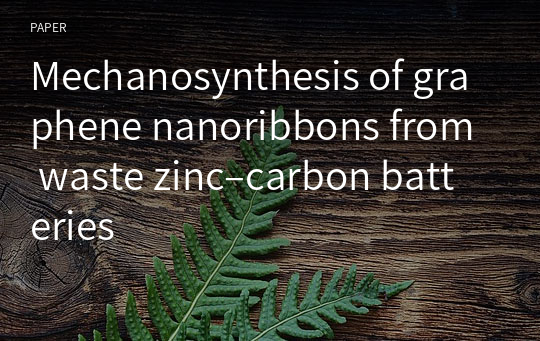Mechanosynthesis of graphene nanoribbons from waste zinc–carbon batteries
* 본 문서는 배포용으로 복사 및 편집이 불가합니다.
서지정보
ㆍ발행기관 : 한국탄소학회
ㆍ수록지정보 : Carbon letters / 32권 / 2호
ㆍ저자명 : J. Martínez‑González, D. Reyes‑Contreras, Enrique Vigueras‑Santiago, C. Patiño‑Carachure, J. A. Reyes‑Esqueda, V. H. Castrejón‑Sánchez, I. García‑Orozco
ㆍ저자명 : J. Martínez‑González, D. Reyes‑Contreras, Enrique Vigueras‑Santiago, C. Patiño‑Carachure, J. A. Reyes‑Esqueda, V. H. Castrejón‑Sánchez, I. García‑Orozco
목차
Abstract1 Introduction
2 Experimental details
2.1 Graphite raw material obtaining
2.2 Synthesis of graphene nanoribbons
2.3 SEM–EDS analysis
2.4 TEM characterization
2.5 Characterization by Raman spectroscopy
3 Results and discussion
3.1 SEM–EDS analysis
3.2 TEM analysis
3.3 Raman spectra results
3.4 Mechanism for generation of GNRs
4 Conclusions
Acknowledgements
References
영어 초록
The mechanosynthesis route is a physical top–down strategy to produce different nanomaterials. Here, we report the formation of graphene nanoribbons (GNRs) through this route using carbon bars recovered from discarded alkaline batteries as raw material. The mechanosynthesis time (milling time) is shown to have an influence on different features of the GNRs such as their width and edges features. TEM revealed the presence of GNRs with widths of 15.26, 8.8, and 23.55 nm for the milling times of 6, 12, and 18 h, respectively. Additionally, the carbon bars evolved from poorly shaped GNRs for the shortest milling time (6 h) to well-shaped GNRs of oriented sheets forming for the longest milling time. Besides GNRs, graphene sheets (GNS) of different sizes were also observed. The Raman analysis of the 2D bands identified the GNS signal and confirmed the GNRs nature. ID/IG values of 0.21, 0.32, and 0.40 revealed the degree of disorder for each sample. The in-plane sp2 crystallite sizes ( La) of graphite decreased to 91, 60, and 48 nm with increasing peeling time. The RBLM band at 288 cm− 1 confirmed the formation of the GNRs. Mechanosynthesis is a complex process and the formation of the GNRs is discussed in terms of a mechanical exfoliation, formation of graphene sheets and its fragmentation to reach GNR-like shapes. It is shown that the synthesis of GNRs through the mechanosynthesis route, besides the use of recycled materials, is an alternative for obtaining self-sustaining materials.참고 자료
없음"Carbon letters"의 다른 논문
 C/SiO2 and C/SiC composite foam monoliths from rice hus..13페이지
C/SiO2 and C/SiC composite foam monoliths from rice hus..13페이지 Optical method for detecting the concentration of sucro..9페이지
Optical method for detecting the concentration of sucro..9페이지 Investigation and analysis of surface roughness in mach..13페이지
Investigation and analysis of surface roughness in mach..13페이지 Properties of pitch‑like materials obtained using coal ..10페이지
Properties of pitch‑like materials obtained using coal ..10페이지 Hexagonal cerium oxide decorated on β‑Ni(OH)2 nanosheet..14페이지
Hexagonal cerium oxide decorated on β‑Ni(OH)2 nanosheet..14페이지 Preparation of ethanediamine‑doped carbon quantum dots ..9페이지
Preparation of ethanediamine‑doped carbon quantum dots ..9페이지 A study on the correlation between microstructure chang..13페이지
A study on the correlation between microstructure chang..13페이지 Study on the structure of reduced graphene oxide prepar..10페이지
Study on the structure of reduced graphene oxide prepar..10페이지 One‑step green synthesis and dispersion characteristics..9페이지
One‑step green synthesis and dispersion characteristics..9페이지 Electrocatalytic oxygen reduction of three‑dimensional ..10페이지
Electrocatalytic oxygen reduction of three‑dimensional ..10페이지


























